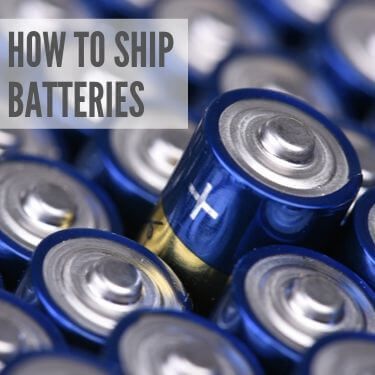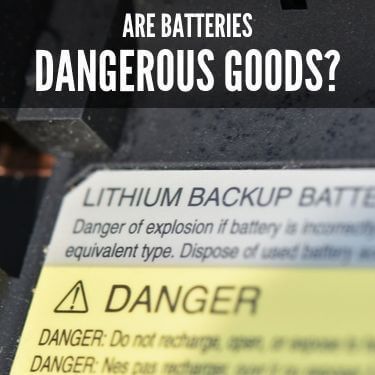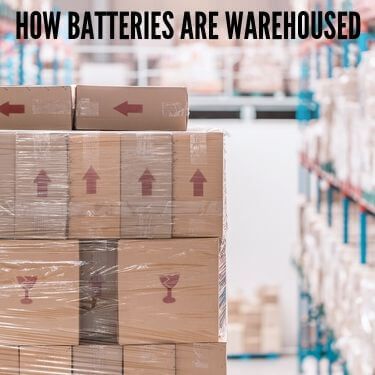
 Copy URL to Clipboard
Copy URL to Clipboard
Don’t let shipping batteries cause a short circuit in your logistics process. It is important to know the rules and regulations around shipping batteries. Make safe transportation part of your process by learning how to ship batteries.
Batteries are the preferred energy source for many favorite consumer electronics. Cell phones, toys, laptops, tools, tablets and other goods often run on lithium ion batteries. It is important that you consider all safety risks when shipping batteries and battery containing products. Many people are not aware of the risks associated with shipping batteries. According to the International Air Transport Association, lithium batteries can pose a safety concern if not prepared and packed within transport regulations.
Table of Contents

Lithium ion batteries and battery containing products are considered dangerous goods (HAZMAT). According to information from the Federal Aviation Authority, there have been a number of incidents related to shipping lithium batteries via airplane. Numbers released in August of 2018 suggest more than 210 incidents with batteries have occured on planes and in airports since 1991. This includes both passenger planes and cargo planes. These risks can make lithium batteries a hot topic for shippers. It is important to realize the risks associated with lithium battery shipping.
There are a few precautions to take when shipping batteries. With some types of batteries, like alkaline and non-spillable acid batteries, require minimal precautions. Other batteries, like lithium ion batteries, require extra care.
When shipping alkaline and non-spillable batteries, it is important that strong outer packaging is selected. It is also wise to protect battery terminals to prevent short circuit or sparking. Interior components should also be protected from metal objects and tools.
When shipping lithium ion batteries, other precautions must be taken. These items are regulated as hazardous material for shipping and transportation. In addition to the basic safety precautions you should take with alkaline and non-spillable batteries, lithium ion batteries might require the use of hazard labeling, special packaging and documents indicating compliance.
There are a few other rules to follow when shipping batteries. Rules to follow include:
Following these rules when shipping batteries can help keep your shipment safe.

There are a number of things to keep in mind when warehousing batteries before shipment. Batteries have a finite shelf life and you can only keep them in the warehouse for so long. You might use a warehousing system like FEFO (first expiring, first out) or FIFO (first in, first out) to keep the batteries in your warehouse fresh and moving smoothly.
There are a few protocols to follow when thinking about battery shelf life. Most batteries should be kept in a climate controlled warehouse, as in some cases higher temperatures can damage the battery cells. The optimal temperature for storing batteries depends on what the cells are made of.
Primary cell batteries need to be stored properly. They are not rechargeable and any power loss during storage is detrimental to the efficiency of the battery. These batteries should be stored at temperatures above freezing, but no more than 50 degrees fahrenheit.
Nickel cadmium batteries are a type of rechargeable batteries. They can be stored at a wider range of temperatures than primary cell batteries. They can withstand warmer temperatures. It is safe to store nickel cadmium batteries at temperatures up to 100 degrees fahrenheit. Climate controlled warehousing is not as important with nickel cadmium batteries.
Nickel Metal Hydride (NiMH) batteries are also rechargeable. Their storage requirements are very similar to nickel cadmium batteries. They can also withstand warmer temperatures, up to 100 degrees fahrenheit. Climate controlled warehousing is not as important with NiMH batteries.
Lithium battery handling requires a few more precautions that other batteries. While they can be stored for short amounts of time in non-climate controlled warehouses, lower temperatures are most ideal. Store temperatures between 59 and 77 degrees fahrenheit is best for prolonged battery life. Additionally, it is important to know that lithium ion batteries should be stored at a charge between 30 and 50 percent. The same rules apply for batteries installed in equipment and items that contain lithium ion batteries.
R+L Global Logistics can provide white glove logistics services to make shipping batteries simple. Let R+L Global handle your battering storage, fulfillment and distribution needs, including:
Figuring out how to ship batteries doesn’t have to short circuit your logistics process. Let R+L Global help with your battery shipment, warehousing, fulfillment and distribution needs. Call 866-989-3082, email or chat today for additional information or to get started with logistics services.
